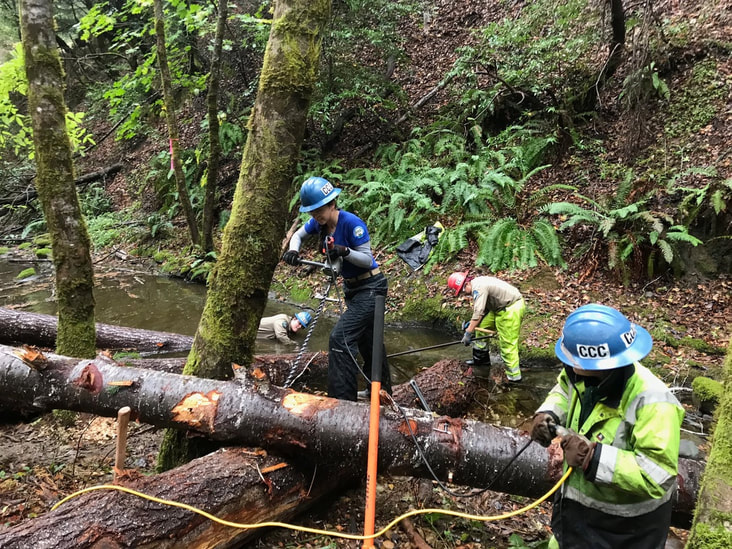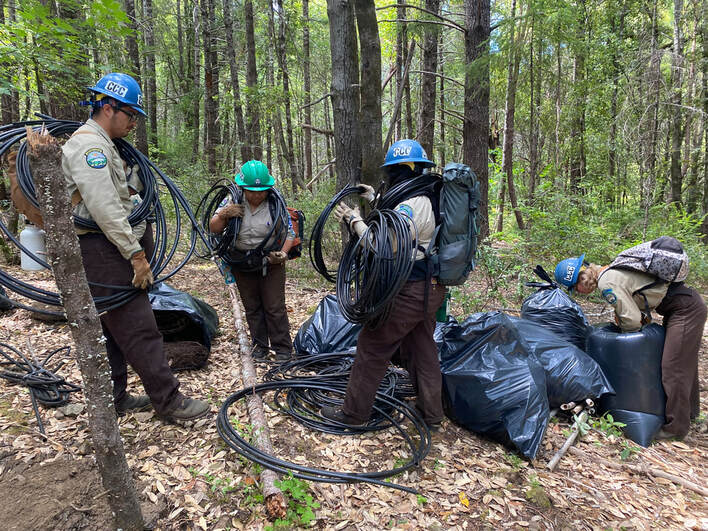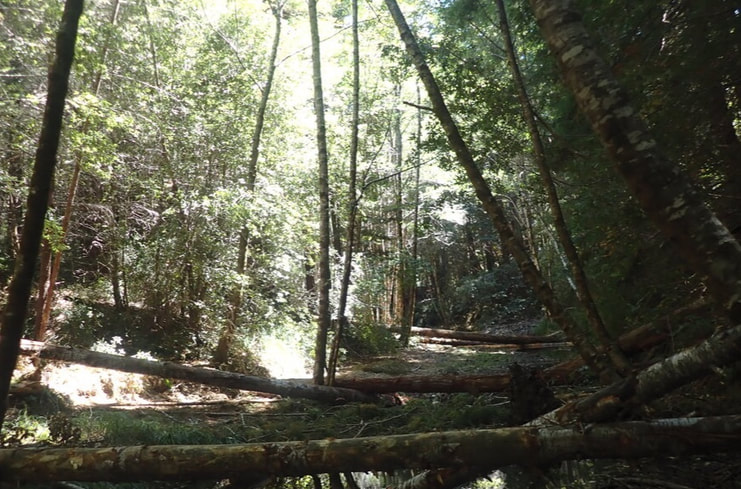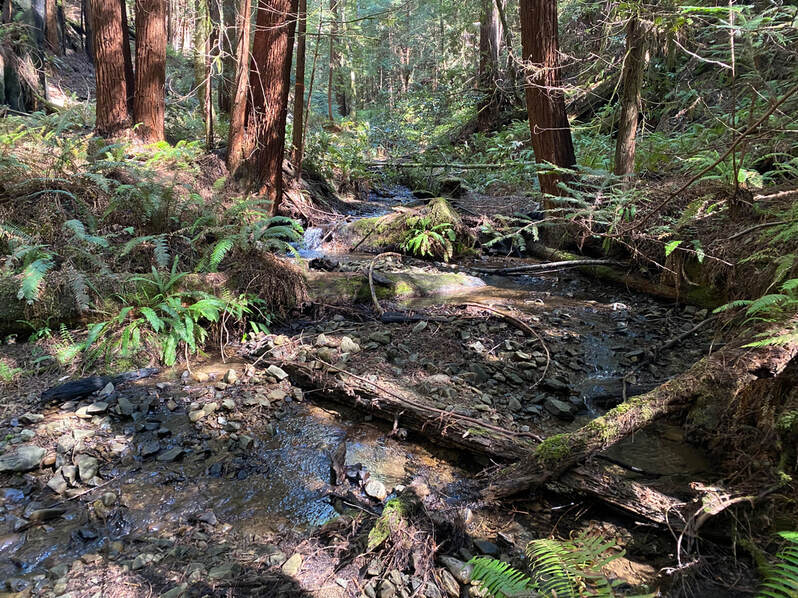Willits Creek Instream Restoration Project
The Willits Creek Instream Restoration Project is located on Willits Creek, a tributary to Mill Creek, which flows into Outlet Creek, and eventually into the Eel River. Willits Creek is severely lacking large wood (LW) in the stream channel, which negatively affects the quality and quantity of salmonid habitat within the watershed. This project aims to enhance salmonid habitat by installing 172 pieces of large wood across 54 locations along 2 miles of the creek. These additions will improve geomorphic function, instream refugia, and access to floodplains, ultimately increasing salmonid survival. Post-restoration, 100 native trees and 50 native shrubs will be planted in disturbed areas. The ultimate goal of this project is to increase salmonid survival by enhancing the instream habitat of Willits Creek.
The Project received funds through the CDFW from the Fisheries Restoration Grant Program (FRGP).
The Project received funds through the CDFW from the Fisheries Restoration Grant Program (FRGP).
Sproul Creek Salmon Habitat Restoration Project
The Sproul Creek watershed is a very important for Coho recovery within the South Fork Eel Watershed and has been identified as a high priority for restoration by the Salmon Habitat Restoration Priorities (SHaRP) team. Historical logging practices in the Sproul Creek watershed resulted in an out of balance stream. A lack of obstructions to stream flow, as well as a long history of road building near the stream has led to a lack of in-stream habitat as well as little off channel habitat.
Sproul hosts all three salmonid species and provides year-round rearing and spawning habitat. The project reach has potential for high quality pool and off channel habitat, but is lacking the necessary complexity to reach its full potential. This project will remedy anthropogenic impacts to the stream through large wood loading, which will help restore geomorphic function and ecological complexity to Sproul Creek.
This is a two part project that takes place on Green Diamond Resource Company property. Over the course of two years we will be partnering with Edwards Excavation & Restoration as well as the California Conservation Corps (CCC) to place a total of 576 pieces of large wood along 5 miles of Sproul Creek. This project will provide habitat to Coho, Chinook and steelhead. These habitats will also be exceptionally suitable for lamprey adults and ammocoetes. Additionally, 300 conifer seedlings and 100 native plants will be planted along the project reach.
The Project received funds through the CDFW from the Fisheries Restoration Grant Program (FRGP).
Marshall Ranch Cannabis Trash Cleanup
This project is located on the Marshall Ranch. We have been working with the Marshall family for many years doing various restoration projects on their private property. Most recently ERWIG partnered with the California Conservation Corps to clean up 1460 lbs of trash related to trespass cannabis grows. There were a handful of known locations that the land manager had discovered, but as we began following old diversion and irrigation pipes, and started collecting huge tarps, grow bags and other materials we found multiple new locations. These trespass grows can have a big impact on the ecosystem when they are active but continue to be harmful even years after they have been abandoned.
This Cannabis Trash Cleanup was funded by CDFW through the Environmental Restoration and Protection Account.
This Cannabis Trash Cleanup was funded by CDFW through the Environmental Restoration and Protection Account.
Upper Hollow Tree Wood Loading Project
This project is located on Hollow Tree Creek, a tributary to the South Fork Eel River. Much of the Hollow Tree Creek watershed, including most of the headwaters and the entire project reach, is owned by Mendocino Redwood Company (MRC) and is managed for industrial timber production. MRC has spent the last 15 years working with various entities to improve stream conditions through: fish passage enhancement, sediment reduction, and habitat enhancement.
ERWIG and the California Conservation Corps (CCC) assessed the habitat along the Upper Hollow Tree project reach and found existing large wood (LW) to be well below SONCC target values. The lack of LW is tied to low shelter values, reduced gravel sorting, shallower pools and a simple, single-thread channel. The 2002 CDFW stream inventory assessment and the 2014 CDFW South Fork Eel River Watershed Assessment both agree with the findings of the ERWIG/CCC assessment that a lack of LW is resulting in decreased habitat values. During the ERWIG/CCC habitat assessment, locations suitable for habitat enhancement LW structures were identified and LW structures were designed to best optimize habitat at each location.
This project was the construction of 76 LW structures with a total of 271 pieces of LW. The LW structures were placed and secured by Edwards Excavation & Restoration as well as the California Conservation Corps along 2.1 miles of Hollow Tree Creek. This project exceeds SONCC target values of "very good" for number of pieces of LW per mile. These structures will enhance pool area and depth, increasing shelter complexity, increasing the frequency of floodplain and side channel inundation, aggregate the channel, capturing large and small wood, and providing velocity refugia during high flows.
The Project received funds through the CDFW from the Fisheries Restoration Grant Program (FRGP).
South Fork Cottaneva Creek Watershed Habitat Enhancement
The Project is located SF Cottaneva Creek, tributary to Cottaneva Creek, in Rockport, California, Mendocino County. The project area is owned by Mendocino Redwood Company (MRC) and is managed for industrial timber production. The SF Cottaneva Creek project reach starts 1.5 miles upstream from the confluence with Cottaneva Creek and extends upstream approximately 1.4 miles. The Slaughterhouse Gulch reach starts at the confluence with SF Cottaneva and extends 0.78 miles upstream.
The purpose of the Project is to improve instream habitat for salmonids in South Fork (SF) Cottaneva Creek Watershed. The Project is necessary because the lack of large wood (LW) in the stream channel has negatively affected the quality and quantity of salmonid habitat within the watershed.
The specific objective(s) of this Project are to install 223 pieces of LW at approximately 77 feature locations in SF Cottaneva Creek and Slaughterhouse Gulch, a tributary to SF Cottaneva Creek. In SF Cottaneva Creek, 141 pieces of LW will be installed at 43 locations and in Slaughterhouse Gulch, 82 pieces of LW will be installed at 34 locations. Additionally, 220 redwood saplings and 50 native shrubs will be planted in the riparian zone along the project reach.The goal of this project is to increase Coho Salmon and steelhead trout reproductive success and juvenile survival by increasing pool area and depth, increasing shelter complexity, sorting substrate for spawning habitat, increasing the frequency of side channel and floodplain inundation, capturing large and small wood, and providing velocity refugia during high flows. Planting native trees and shrubs will improve riparian canopy and provide future LW recruitment.
The Project received funds through the CDFW from the Fisheries Restoration Grant Program (FRGP).
The purpose of the Project is to improve instream habitat for salmonids in South Fork (SF) Cottaneva Creek Watershed. The Project is necessary because the lack of large wood (LW) in the stream channel has negatively affected the quality and quantity of salmonid habitat within the watershed.
The specific objective(s) of this Project are to install 223 pieces of LW at approximately 77 feature locations in SF Cottaneva Creek and Slaughterhouse Gulch, a tributary to SF Cottaneva Creek. In SF Cottaneva Creek, 141 pieces of LW will be installed at 43 locations and in Slaughterhouse Gulch, 82 pieces of LW will be installed at 34 locations. Additionally, 220 redwood saplings and 50 native shrubs will be planted in the riparian zone along the project reach.The goal of this project is to increase Coho Salmon and steelhead trout reproductive success and juvenile survival by increasing pool area and depth, increasing shelter complexity, sorting substrate for spawning habitat, increasing the frequency of side channel and floodplain inundation, capturing large and small wood, and providing velocity refugia during high flows. Planting native trees and shrubs will improve riparian canopy and provide future LW recruitment.
The Project received funds through the CDFW from the Fisheries Restoration Grant Program (FRGP).






